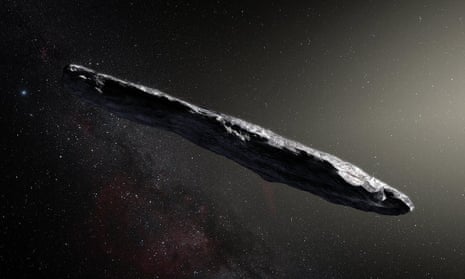Astronomers are to use one of the world’s largest telescopes to check a mysterious object that is speeding through the solar system for signs of alien technology.
The Green Bank telescope in West Virginia will listen for radio signals being broadcast from a cigar-shaped body which was first spotted in the solar system in October. The body arrived from interstellar space and reached a peak speed of 196,000 mph as it swept past the sun.
Scientists on the Breakthrough Listen project, which searches for evidence of alien civilisations, said the Green Bank telescope would monitor the object, named ‘Oumuamua, from Wednesday. The first phase of observations is expected to last 10 hours and will tune in to four different radio transmission bands.
“Most likely it is of natural origin, but because it is so peculiar, we would like to check if it has any sign of artificial origin, such as radio emissions,” said Avi Loeb, professor of astronomy at Harvard University and an adviser to the Breakthrough Listen project. “If we do detect a signal that appears artificial in origin, we’ll know immediately.”
The interstellar body, the first to be seen in the solar system, was initially spotted by researchers on the Pan-Starrs telescope, which the University of Hawaii uses to scan the heavens for killer asteroids. Named after the Hawaiian word for “messenger”, the body was picked up as it swept past Earth at 85 times the distance to the moon.
While many astronomers believe the object is an interstellar asteroid, its elongated shape is unlike anything seen in the asteroid belt in our own solar system. Early observations of ‘Oumuamua show that it is about 400m long but only one tenth as wide. “It’s curious that the first object we see from outside the solar system looks like that,” said Loeb.
The body is now about twice as far from Earth as the sun, but from that distance the Green Bank telescope can still detect transmissions as weak as those produced by a mobile phone. Loeb said that while he did not expect Green Bank to detect an alien transmission, it was worth checking.
“The chances that we’ll hear something are very small, but if we do, we will report it immediately and then try to interpret it,” Loeb said. “It would be prudent just to check and look for signals. Even if we find an artefact that was left over and there are no signs of life on it, that would be the greatest thrill I can imagine having in my lifetime. It’s really one of the fundamental questions in science, perhaps the most fundamental: are we alone?”
The Breakthrough Listen project was launched at the Royal Society in London in 2015, when the Cambridge cosmologist Stephen Hawking announced the effort to listen for signs of life on planets that orbit the million stars closest to Earth. The $100m project is funded by the internet billionaire Yuri Milner, and has secured time on telescopes in the US and Australia to search for alien civilisations.
Astronomers do not have good ideas about how such elongated objects could be created in asteroid belts. By studying ‘Oumuamua more closely, they hope to learn how they might form and whether there are others in the solar system that have so far gone unnoticed. “If it’s of natural origin, there should be many more of them,” Loeb said.
Previous work on the body found it to be extremely dark red, absorbing about 96% of light that falls on it. The colour is associated with carbon-based molecules on comets and asteroids.
If, as expected, the telescope fails to pick up any intelligent broadcasts from ‘Oumuamua, the observations are still expected to aid scientists in understanding the body. Other signals detected by the Green Bank telescope could shed light on whether the object is shrouded in a comet-like cloud of gas, and reveal whether it is carrying water and ice through the solar system.










Comments (…)
Sign in or create your Guardian account to join the discussion